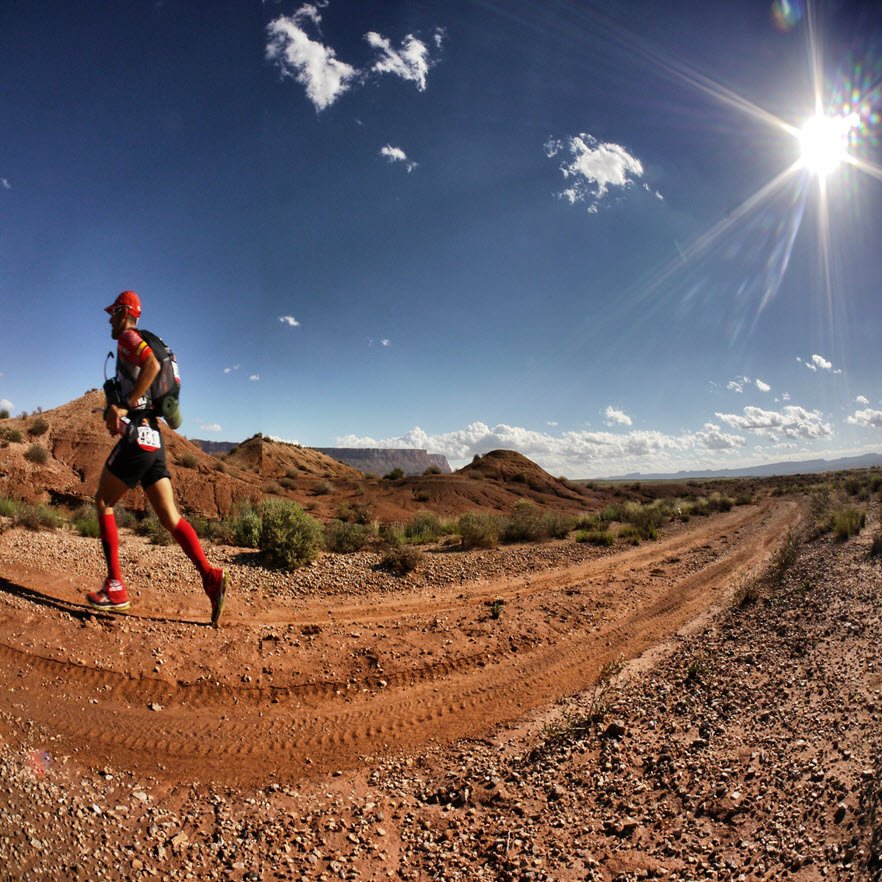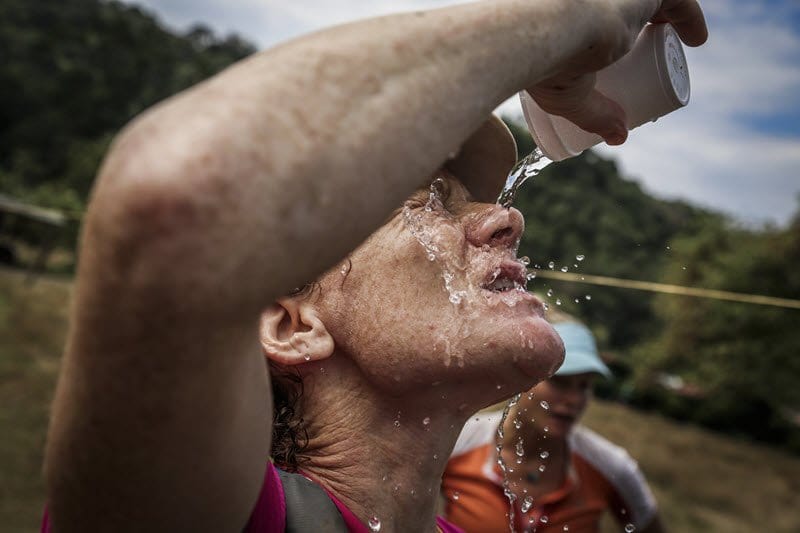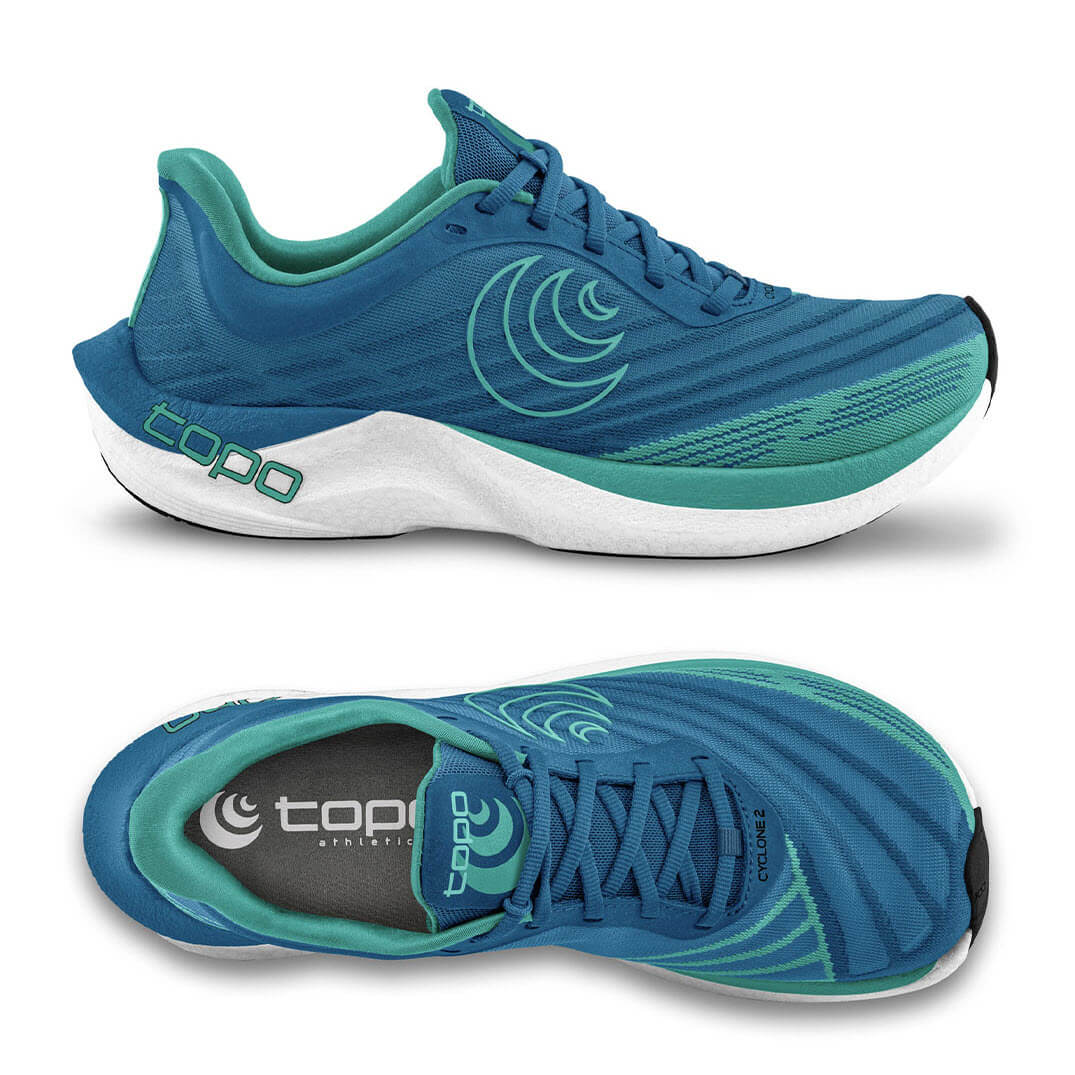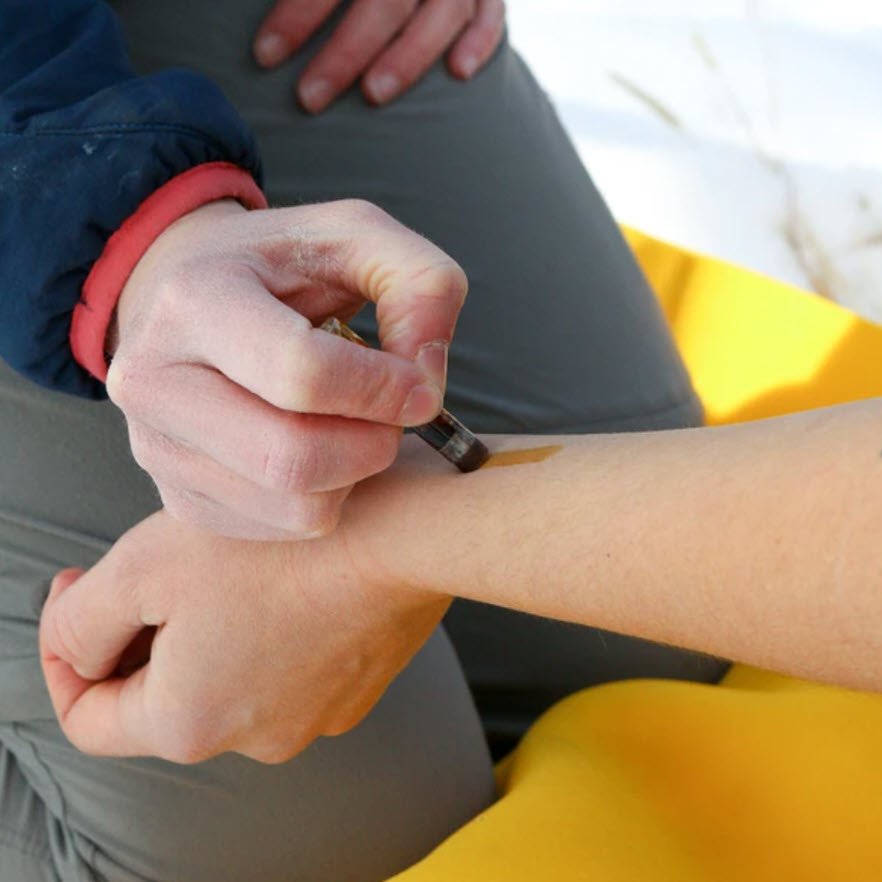Hot days make for sweaty feet. Especially when they're wrapped in shoes and socks and you're exercising - it's unavoidable! I'm sure you know, moisture (from perspiration) increases friction levels and therefore blisters. So one of the first things people focus on is the question of "how do I keep my feet dry?"
It's not just hot days either. Or exercise. Moisture can come from sweat, dew, rain, snow, puddles, river-crossings and even tipping water over your head mid-race to cool down.
This article will look at the various methods of moisture-management and discuss how they work, the research behind their use, and their limitations.
Skin Hydration and Friction Levels
But first, let's just confirm the link between moisture, friction and blisters.
We know friction levels are lower on DRY skin compared to MOIST skin. Much research has been performed to determine the coefficient of friction (COF) of human skin, both dry and wet against various materials, and with various topical products applied (1-8). For example:
- Naylor (1) tested subjects in a heated room to encourage perspiration. He found that air blown over the skin (ie: drying effect) resulted in an immediate reduction in COF. And when the skin was wiped with ether (ie: skin greases removed), friction levels immediately increased.
- Sivamani et al (6) found Isopropyl alcohol visibly dried the skin and reduced friction levels.
Skin hydration is known to increase skin friction and the likelihood of blisters (1, 8-14).
So It's Entirely Appropriate To Aim To Keep Your Feet Dry To Curb Blister Formation
Not sure what to use to keep your feet dry? Here's what people use to try and keep their feet dry.
1) Antiperspirants
The always-present source of moisture on the feet is sweat. So it makes sense that one would try antiperspirants. The less sweat, the drier the skin, right? But will any old ‘under-arm’ antiperspirant do the trick? If you look at the research, the answer is no!
- Darrigrand et al (15) found a non-statistically significant reduction of foot blisters with the use of one of two antiperspirants (aluminum chlorohydrate and aluminum zirconium tetrachlorohydrex glycine) in a group of 19 male soldiers completing a one-hour treadmill march in warm conditions. But there was also an increased incidence of irritant dermatitis.
- Knapik et al (16) looked at a group of 667 military cadets who applied either an antiperspirant (20% aluminum chloride hexahydrate in anhydrous ethyl alcohol) or placebo (anhydrous ethyl alcohol) to their feet for 3 nights preceding a 21km hike. The incidence of foot blisters was 21% for the antiperspirant group and 48% for the placebo group. However, incidence of skin irritation was 57% for the antiperspirant group and 6% for the placebo group.
- Reynolds et al (17) compared the effect of an antiperspirant (20% aluminum zirconium tetrachlorohydrex glycine concentration plus water) with emollient additives, with the emollient additives alone (placebo) and no treatment groups. While irritant dermatitis was eliminated, blister incidence was similar among all groups.
- Hashmi et al (18) found an antiperspirant (Boots Anti-Perspirant Foot Spray) did not affect skin hydration on the foot.
2) Powders
Talc and cornstarch powders have the ability to soak up moisture. So conceivably, they can be used to keep your skin drier than it otherwise would be. However, a look at the research shows it's effect is limited, and it has a downside that can actually cause blisters.
- Powders have been used on skin friction studies to effect drier skin (1, 2). Because of this, they have been advocated as a method for preventing blisters. In fact, powders potentially have a double friction-reducing mechanism. First, they absorb water to encourage drier skin. And second, they work as a dry lubricant.
- However, preliminary British Army research has shown talc powders have either shown no difference when compared with a control group or a higher blister incidence among those using the powder (19).
- “Three British military studies examined the influence of foot powders on blister formation. Quinn (1967) performed an 18-week investigation of 135 recruits in basic training. Comparison of a group that did not use foot powders with three separate groups using talc-based powders revealed no difference among groups in foot blister incidence. Two observational studies of infantry troops were performed, but neither of these specified the type of powder used. In the first study (Allan, 1964), soldiers performed eight 10-mile walks over a 12-day period. Soldiers using foot powder actually had a higher blister incidence than soldiers not using foot powder. In the second study (Allan and Macmillan, 1963) soldiers walked 14 miles each of three consecutive days on 3 occasions (9 days of walking). Soldiers using foot powder did not differ in the number of blisters per man compared to soldiers not using powder.” (19)
- When talc is wet, frictional forces have been found to increase (2). It has also been suggested that when sweat and powder combine, it clumps and becomes abrasive (19).
- Hashmi et al (18): “The therapeutic use of powder in friction blister management has only been suggested and not fully tested in the literature, although it is known that when powder absorbs moisture (either from the skin or the environment) the coefficient of friction on the skin surface increases.” Hashmi and colleagues tested three topical agents, one of them being 2Toms BlisterShield Powder, the others were an antiperspirant and film-forming product. Unlike most powders (talc/starch), BlisterShield Powder is made of polytetrafluoroethylene (PTFE) and is markedly hydrophobic. In the study, this powder was shown to reduce skin surface hydration, suggesting a potential blister preventive effect. But none of the products tested impacted on rate of temperature change, thought to be predictive of blister formation.
While the effectiveness of powders is equivocal, if you choose to use use a powder, frequent reapplication will be necessary to keep your feet dry. Reapplying is better than using too much in one application because what you'll end up with is a pasty lump of goo that will lodge somewhere (often between the toes) and cause a blister (or fungal infection) elsewhere. I review some of these in this video (but mostly the lubricant side of the equation).
3) Other Topical Skin Drying Methods
Many people swear by preparing their feet for an event weeks in advance with drying applications like strong salty water, cold black tea soaks, Condy's crystals (potassium permanganate), alcohol wipes etc. These preparations do dry the skin and will allow you to start with dry skin! But I'm not sure you can expect the skin to stay dry for long. There is no skin friction or blister prevention research on these preparations. But these methods are favoured by some of the most extreme athletes and described by John Vonhof in his book Fixing Your Feet.
4) Moisture-Wicking Socks
Moisture wicking is a term you've probably heard of in relation to sports and hiking socks. It refers to a moisture transport function that some materials have, mainly synthetics and synthetic blends. Moisture-wicking socks have the ability of a sock to move moisture from the skin side of the sock, to the outerside of the sock. To work best, you need to be wearing a shoe with a breathable upper so this moisture can be evaporated through the shoe. Like the mesh of most joggers.
It's common knowledge among athletes and hikers that cotton socks should be avoided if you want to keep your feet dry. The reason is they are the opposite of moisture-wicking. Cotton fibres retain moisture (hydrophilic) thereby keeping the skin wetter and increasing skin friction levels. But the research shows an unexpected twist when it comes to cotton.
Herring and Richie (20) looked at 35 long-distance runners and compared blister incidence in padded socks of identical construction, but made from different materials – either 100% cotton or 100% acrylic fibers. The results were twice as many blisters in the cotton sock group and they were three times the size. This suggests acrylic fibers were beneficial over cotton fibers in athletic socks. Presumably, this is because of the moisture-management capacity. Their follow-up study (21) eliminated the padded construction and sought to confirm the same blister incidence. This time, both the 100% cotton and 100% acrylic socks were thin. Surprisingly, the acrylic sock lost its blister protection. This suggests that the thickness of a sock is more important to blister prevention than the type of fiber used. So, while cotton is known to exhibit inferior frictional properties in the presence of moisture when compared to synthetics, it's more complex than at first sight.
The preventive effect of the first study must not have resulted simply from friction reduction by way of moisture-management. Otherwise, the thin socks used in the second study would have shown the same superiority of acrylic over cotton. Rather, it seems likely a socks ability to prevent blisters comes through some other mechanism related to its thickness, perhaps either pressure-management or shear absorption, rather than any moisture-wicking to keep your feet dry.
5) Don't Tip Water Over Your Head
That water runs down your legs and soaks into your socks. When it comes to river crossings, if you really want to keep your feet dry, you'd remove your shoes and socks, cross, dry your feet, and don your footwear again. Without doing this, you not only risk blisters, but you risk maceration if you keep your waterlogged socks and shoes on all day. Maceration, sometimes known as trench foot, severely weakens the skin. To learn more about maceration, I’ve written three comprehensive articles on what maceration is, how it weakens the skin, how to treat it and how to prevent it. There are some pretty nasty pictures in these articles, so don’t say I didn’t warn you! Needless to say, prevention is the key, so at least read the last article.
6) Changing Socks / Airing Feet, Shoes & Insoles To Keep Your Feet Dry
If you've hiked for several days at a time, I bet you've taken your shoes and socks off at rest breaks in an effort to keep your feet dry. Perhaps you've even changed your socks too. But have you aired your shoes and insoles? You really must take your insoles out because they are the things that absorb a lot of perspiration. And if you've had a waterlogging situation, take your insoles out and wring them out. Get as much water out of them as you can to give them any chance of drying overnight.
7) Gaiters
Gaiters can be used to good effect to keep environmental water out of the shoe. This will obviously depend on the degree to which the gaiter is attached to the shoe and the water-resistance of the material used. Particularly for ultramarathons that take place over terrain involving dewey grasses, puddles, rain or snow, full covering of the shoe with velcro attachment is ideal. A bootmaker/cobbler is the best person to see to attach the velcro to your shoe.
Learn more about standard hiking and running gaiters and full-shoe gaiters.
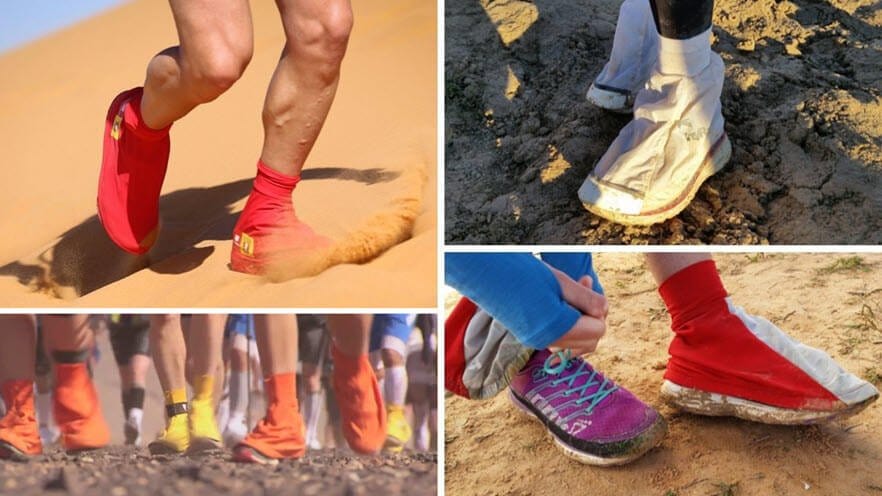
So How Effective Are Skin Drying Strategies?
The research summarised above seems to indicate that sweat-related skin drying strategies aren't particularly effective at reducing skin hydration, reducing friction levels or reducing blister formation.
Sure, you can go some way to reduce the amount of water entering your footwear. However, maintaining dry feet in ordinary athletic situations and in spite of perspiration is hardly practical. I'd go so far as to say it's impossible, especially in an athletic or endurance activity situations. Your feet are never going to be the kind of DRY required for low friction - it's always going to be some level of clammy and MOIST.
That's why, for many years now, I largely ignore the influence of low-level moisture to blister formation. Effective blister prevention is still possible. Indeed, effective friction-management is very possible in spite of sweaty feet.
How To Take Moisture Out Of The Blister Equation
If keeping your feet dry is so difficult to achieve, and considering skin drying strategies are minimally effective, much better would be to assume high skin moisture and work on friction levels in other ways.
Friction-management strategies are typically applied to the skin. The relatively ineffective powders, lubricants and antiperspirants are examples. But friction-management can occur at other interfaces. Take double-socks for example. They manipulate friction levels at the sock-sock interface and I'd recommend ArmaSkin socks as the best choice. On the other hand, ENGO Blister Patches manipulate friction levels at the shoe-sock interface. Impressively, these patches maintain low friction levels regardless of moisture. Take a look at the graph below. You can learn more about how ENGO Patches take moisture out of the blister equation here, and I highly recommend you do.
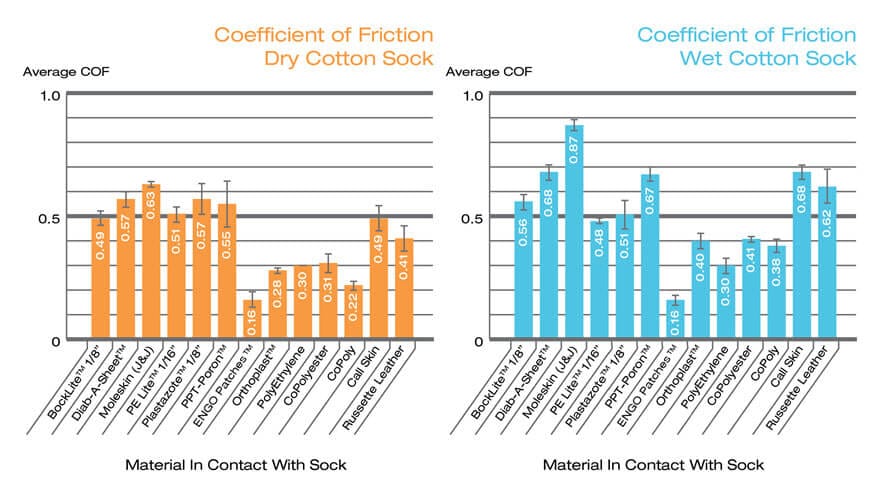
Friction levels of various in-shoe materials in dry and moist conditions.
References
- Naylor PFD. The skin surface and friction. Br J Dermatol. 1955;67(7):239-248. doi:10.1111/j.1365-2133.1955.tb12729.x
- Comaish S and Bottoms E. The skin and friction: Deviations from Amonton’s Laws and the effects of hydration and lubrication. Br J Dermatol. 1971;S4(37):37-43.
- Cua AB, Wilhelm K-P, Maibach HI. Frictional properties of human skin: relation to age, sex and anatomical region, stratum corneum hydration and transepidermal water loss. Br J Dermatol. 1990;123:473-479.
- Zhang M, Mak AFT. In vivo friction properties of human skin. Prosthet Orthot Int. 1999;23:135-141.
- Sanders JE, Greve JM, Mitchell SB, Zachariah SG. Material properties of commonly-used interface materials and their static coefficients of friction with skin and socks. J Rehabil Res Dev. 1998;35(2):161-176.
- Sivamani RK, Goodman J, Gitis N V, Maibach HI. Friction coefficient of skin in real-time. Ski Res Technol. 2003;9:235-239.
- Sivamani RK, Wu GC, Gitis N V, Maibach HI. Tribological testing of skin products: gender, age, and ethnicity on the volar forearm. Ski Res Technol. 2003;9:299-305.
- Veijgen NK, Masen MA, Van Der Heide E. Relating friction on the human skin to the hydration and temperature of the skin. Tribol Lett. 2013;49(1):251-262. doi:10.1007/s11249-012-0062-1
- Sulzberger MB, Cortese TA, Fishman L, Wiley HS. Studies on blisters produced by friction I - Results of linear rubbing and twisting technics. J Invest Dermatol. 1966;47(5):456-465.
- William A Akers. Sulzberger On Friction Blistering. Int J Dermatol. 1977;16(June):369-372.
- El-Shimi AF. In vivo skin friction measurements. J Soc Cosmet Chem. 1977;(28):37-51.
- Highly D, Coomey M, DenBeste M, Wolfram L. Frictional Properties of Skin.pdf. J Invest Dermatol. 1977;69(3):303-305.
- Kirkham S, Lam S, Nester C, Hashmi F. The effect of hydration on the risk of friction blister formation on the heel of the foot. Ski Res Technol. 2014;20(2):246-253. doi:10.1111/srt.12136
- Hashmi F. Friction Foot Blisters: The Effect of Hydration on the Risk of Blister Creation. In: Agache’s Measuring the Skin. Springer, Cham; 2015:1487-1494. doi:10.1007/978-3-319-26594-0_145-1
- Darrigrand A, Reynolds K, Jackson R, Hamlet M, Roberts D. Efficacy of antiperspirants on feet. Mil Med. 1992;157(5):256-259.
- Knapik JJ, Hamlet MP, Thompson KJ, Jones BH. Influence of boot-sock systems on frequency and severity of foot blisters. Mil Med. 1996;161(10):594-598. doi:10.1093/milmed/161.10.594
- Reynolds K, Darrigrand A, Roberts D, et al. Effects of an antiperspirant with emollients on foot-sweat accumulation and blister formation while walking in the heat. J Am Acad Dermatol. 1995;33(4):626-630.
- Hashmi F, Kirkham S, Nester C, Lam S. The effect of topical anti blister products on the risk of friction blister formation on the foot. J Tissue Viability. 2016;25(3):167-174. doi:10.1016/j.jtv.2016.04.002
- Knapik JJ, Reynolds KL, Duplantis KL, Jones BH. Friction Blisters: Pathophysiology, Prevention and Treatment. Sport Med. Published online 1995. doi:10.2165/00007256-199520030-00002
- Herring KM, Richie DH. Friction blisters and sock fiber composition. A double-blind study. J Am Podiatr Med Assoc. 1990;80(2):63-71.
- Herring KM and Richie DH. Comparison of cotton and acrylic socks using a generic cushion sole design for runners. J Am Podiatr Med Assoc. 1993;83(9):515-522.
- Carlson, JM. 2006. CPO Functional Limitations From Pain Caused by Repetitive Loading on the Skin: A Review and Discussion for Practitioners, With New Data for Limiting Friction Loads, JPO Journal of Prosthetics and Orthotics: October - Volume 18 - Issue 4 - p 93-103
